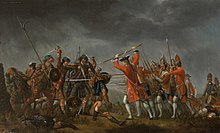
The Highland charge was a battlefield shock tactic used by the clans of the Scottish Highlands which incorporated the use of firearms.

The Highland charge was a battlefield shock tactic used by the clans of the Scottish Highlands which incorporated the use of firearms.
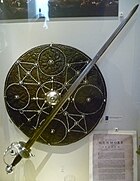
Prior to the 17th century, Highlanders fought in tight formations, led by a heavily armed warrior elite who carried heavy battle axes or claymores (two-handed swords whose name comes from the Scottish Gaelic claidheamh mòr, meaning "great sword").
However, with the introduction of muskets and cannon, such formations became vulnerable. As a result, in the 17th century, Highlander warriors developed a lighter, one-handed, basket-hilted broadsword that protected the hand. This was generally used with a shield or targe strapped to the weak arm and a dirk or biotag ("long knife") held in the other hand.
The Scottish and Irish warrior Alasdair Mac Colla is sometimes credited with inventing the Highland charge during the Wars of the Three Kingdoms [1] to meet a particular set of battlefield challenges. [2] It was initially known as the Irish charge, due to the Irish component of Alasdair Mac Colla's Royalist military invasion of Covenanter Scotland. The use of the charge greatly resembled older Celtic fighting styles of battle in which one side would rush at the other in an attempt to break the line of battle. [3] [4]
The charge required a high degree of commitment as the men were rushing into musket range and would suffer casualties from at least one volley. Speed was essential, so the Highlanders preferred to employ the charge downhill and over firm ground; they removed clothing from their lower body for the same reason. They ran forward in clusters of a dozen (often blood relatives), which formed a larger, wedge-shaped formation. Once in effective musket range (60 yards), those with firearms would shoot; gun smoke from this mass discharge having obscured enemies' aim, the Highlanders obtained further protection from the expected return volley from the opposing force by crouching low to the ground immediately after firing. Then, firearms were dropped and edged weapons drawn, whereupon the men made the final rush on the enemy line with a Gaelic battle cry. Upon reaching striking distance, the Highlander would attempt to take the opponent's sword or bayonet point on his targe while lunging in low to deliver an upward thrust to his enemy's torso.[ citation needed ]
The Highlanders are of such a quick motion that if a battalion keep up his fire to be sure of (hitting) them, they are upon it before our men can come to the second defense, which is the bayonet in the muzzle of the musket. [5]
Before the adoption of ring attachments for bayonets, the attachment consisted of a plug inserted into the barrel, which meant a musket could not be fired or reloaded with a fixed bayonet. During their charge Highlanders made a relatively instant transition from firearms to swords as they swiftly closed with the opposing force. Those enemy soldiers with plug attachments (some carried a pike) had only moments to fix bayonets while under psychological pressure from the onrushing Highlanders brandishing swords and roaring their war cries. At the 1689 Battle of Killiecrankie Scottish professional soldiers, veterans of the Dutch Republic's Scots Brigade, were overwhelmed by the Highland Jacobites of Clan Cameron; the Highlanders secured a complete victory by a charge which killed 2000 redcoats for the loss of 800 Highlanders. [6] [7] [8]
The ring bayonet reduced the effectiveness of the Highland charge, but it remained an example of shock tactics, with the key factor being psychological; rather than being an attempt to cut through a solid enemy line, the charge aimed at causing some enemy troops in the opposing line to break ranks before contact, thereby leaving openings which could be exploited to 'roll up' the rest. [9] This happened at the 1644 Battle of Tippermuir and the 1745 Battle of Falkirk Muir.
One of the less successful uses of the Highland charge was in 1746 during the final confrontation of the Jacobite rising of 1745, the Battle of Culloden. The battle pitted the Jacobite forces of Charles Edward Stuart against an army commanded by Prince William, Duke of Cumberland loyal to the British government. The under-nourished and unpaid Jacobite force was badly outnumbered and outgunned by well-trained regular troops who maintained discipline when charged. [10] [11] [12]
Against the advice of his military advisors, Charles Edward Stuart insisted on making a stand against the pursuing army of Cumberland on the open moorland of Culloden with the intention of fighting defensively, a decision that most historians have seen as playing into the hands of the government forces. The Jacobites failed to take advantage of the opportunity of attacking before the enemy had positioned their artillery and were ready for action. Cumberland's artillery bombarded the Jacobite army, which was stationary and exposed, until up to a third of Charles's men were dispersed or made casualties (including a groom decapitated while holding Charles Edward's horse). At this point – and without orders from the Jacobite command – Clan Mackintosh in the centre of the Jacobite line began to charge. Donald Cameron of Lochiel led the Camerons to join them and some other clans followed in a spontaneous charge in which many failed to use their firearms. Despite canister shot and volleys, the charge reached – and in places broke through – the Government front line (though many Highlanders were without targes to protect from bayonets). However, Coehorn mortar shelling and devastating enfilade musket fire from the deeply echeloned government forces killed those who had made a breakthrough, while the others, after suffering heavy casualties, fell back in a retreat that quickly became a rout. [13] [14] [15] [16]

The Battle of Culloden was the final confrontation of the Jacobite rising of 1745. On 16 April 1746, the Jacobite army of Charles Edward Stuart was decisively defeated by a British government force under Prince William Augustus, Duke of Cumberland, on Drummossie Moor near Inverness in the Scottish Highlands. It was the last pitched battle fought on British soil.

The Highlands Services Act 1715, also known as the Disarming Act 1715, was an 18th-century Act of Parliament of Great Britain that was enacted to curtail Jacobitism among the Scottish clans in the Scottish Highlands after the Jacobite rising of 1715. The new law, which came into effect on 1 November 1716, aimed at "securing the peace of the highlands in Scotland". It outlawed anyone in defined parts of Scotland from having "in his or their custody, use, or bear, broad sword, poignard, whinger, or durk, side pistol, gun, or other warlike weapon" unless authorised.
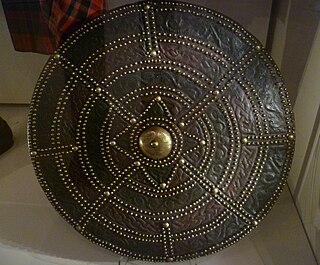
Targe was a shield used by Scottish Highlander in the early modern period. From the late 16th century, until the Battle of Culloden in 1746, the Scottish Highlander's main means of defence in battle was his targe. In February 1596 the clan leader John Grant of Freuchie was able to muster 500 men including 40 armed "according to the Highland custom" with bows, helmets, swords, and targes. After the disastrous defeat of the Jacobites at Culloden, the carrying of the targe had been banned by the Disarming Act, and many were destroyed, or put to other uses. Those that remain have intricate patterns, and are decorated, indicating that they would have originally belonged to important people.

Hugh Mackay was a professional soldier from Sutherlandshire in Scotland, who spent most of his career in the service of William of Orange and later settled in the Dutch Republic. He was killed at the Battle of Steenkerque in July 1692.
Alasdair mac Mhaighstir Alasdair, legal name Alexander MacDonald, or, in Gaelic Alasdair MacDhòmhnaill, was a Scottish war poet, satirist, lexicographer, political writer and memoirist. The poet's Gaelic name means "Alasdair, son of the Reverend Alasdair". His father, also named Alasdair, was known as Maighstir Alasdair which was then the way of referring to a clergyman in Scottish Gaelic. In English, Maighstir Alasdair was known as the "Reverend Alexander MacDonald".
Alasdair Mac Colla Chiotaich MacDhòmhnaill, also known by the English variant of his name Sir Alexander MacDonald, was a military officer best known for his participation in the Wars of the Three Kingdoms, notably the Irish Confederate Wars and Montrose's Royalist campaign in Scotland during 1644–5. A member of the Gaelic gentry of the Clan MacDonald of Dunnyveg, a branch of the Clan Donald active in the Hebrides and Ireland, Mac Colla is particularly notable for the very large number of oral traditions and legends which his life inspired in the Highlands.

The Battle of Falkirk Muir, or Battle of Falkirk, took place near Falkirk, Scotland, on 17 January 1746 during the Jacobite rising of 1745. A narrow Jacobite victory, it had little impact on the campaign.
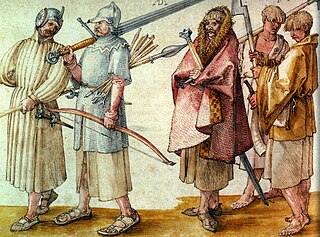
Gaelic warfare was the type of warfare practiced by the Gaelic peoples, in the pre-modern period.
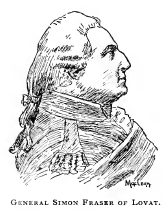
Simon Fraser of Lovat was a son of a notorious Jacobite clan chief, but he went on to serve with distinction in the British army. He also raised forces which served in the Seven Years' War against the French in Quebec, as well as the American War of Independence. Simon was the 19th Chief of the Clan Fraser of Lovat.
Loudon's Highlanders, or the 64th Highlanders, or Earl of Loudon's Regiment of Foot, was an infantry regiment of the British Army.

Redshank was a nickname for Scottish mercenaries from the Highlands and Western Isles contracted to fight in Ireland; they were a prominent feature of Irish armies throughout the 16th century. They were called redshanks because they went dressed in plaids and waded bare-legged through rivers in the coldest weather. An alternative etymology, illustrated by Jamieson by a quote from Sir Walter Scott, is that it referred to the untanned deer leather buskins worn by Highlanders, although Jamieson notes that Scott's source, John Elder of Caithness, actually stated its origin was from their habit of going "bare-legged and bare-footed". The term was not derogatory, as the English were in general impressed with the redshanks' qualities as soldiers.

The Jacobite rising of 1745, also known as the Forty-five Rebellion or simply the '45, was an attempt by Charles Edward Stuart to regain the British throne for his father, James Francis Edward Stuart. It took place during the War of the Austrian Succession, when the bulk of the British Army was fighting in mainland Europe, and proved to be the last in a series of revolts that began in March 1689, with major outbreaks in 1708, 1715 and 1719.
There is some evidence on historical fencing as practised in Scotland in the Early Modern Era, especially fencing with the Scottish basket-hilted broadsword during the 17th to 18th centuries.
The Independent Highland Companies were irregular militia raised from the Scottish clans of the Scottish Highlands by order of the British government between 1603 and 1760 in order to help keep the peace and enforce the law in the Highlands and were recognized as such by the government. The officers of the Independent Highland Companies were commissioned as officers of the British Army but the Independent Companies were not recognized as official regiments of the line of the army. The Independent Highland Companies were the progenitors of the Highland Regiments of the British Army that began when ten Independent Highland Companies were embodied to form the Earl of Crawford's Highland Regiment that was numbered the 43rd Regiment of Foot in 1739.

Warfare in early modern Scotland includes all forms of military activity in Scotland or by Scottish forces, between the adoption of new ideas of the Renaissance in the early sixteenth century and the military defeat of the Jacobite movement in the mid-eighteenth century.
The Campbell of Argyll Militia also known as the Campbell militia, the Argyll militia, or the Argyllshire men, was an irregular militia unit formed in 1745 by John Campbell, 4th Duke of Argyll to oppose the Jacobite rising of 1745.

Alexander Macdonald, 17th of Keppoch was a Scottish Jacobite and clan chief who took part in both the 1715 and 1745 Jacobite risings. He was killed at the Battle of Culloden leading a regiment composed largely of members of his clan, the MacDonalds of Keppoch.

The siege of Culloden House took place on the night of 15/16 October 1745 and was part of the Jacobite rising of 1745. 200 men of the Jacobite Clan Fraser of Lovat attempted to capture Duncan Forbes, Lord Culloden who was the Lord President of the Court of Session, the most senior legal officer in Scotland.
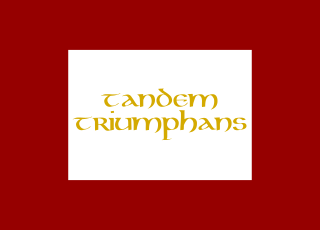
The Jacobite Army, sometimes referred to as the Highland Army, was the military force assembled by Charles Edward Stuart and his Jacobite supporters during the 1745 Rising that attempted to restore the House of Stuart to the British throne.

An Incident in the Rebellion of 1745 is an oil painting, by the Anglo-Swiss artist David Morier. It is part of the art collection of the British royal family. The painting depicts a scene during the 1746 Battle of Culloden, in which a group of Jacobite Army troops charge against a line of government soldiers.